Towards a zero-waste future: Sustainability and design benefits of composite cladding
by arslan_ahmed | March 4, 2024 10:00 am
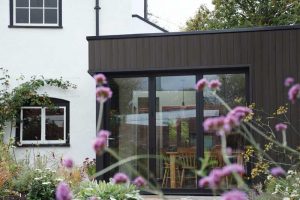 [1]
[1]By Jim Stange
Across the globe, many businesses are working to ensure their operations are as sustainable as possible. Some are even working towards becoming completely zero waste. The Zero Waste International Alliance (ZWIA) defines this as “the conservation of all resources by means of responsible production, consumption, reuse, and recovery of products, packaging, and materials without burning and with no discharges to land, water, or air that threaten the environment or human health.”1
This practice reduces a company’s contribution to the waste stream, lowers its negative environmental impacts, and strengthens its reputation. Such waste reduction strategies can also save the company money and even generate revenue if the waste is valuable to another industry. According to a study by MIT Sloan Management Review,2 90 percent of today’s CEOs report that sustainability is important to their company’s success.
In the building industry, sustainability has been a priority for some time. Determining a product’s sustainability includes considering its material makeup, manufacturing process, end-of-life care, and even its durability. With green building construction, sustainability equals durability. This is because, the longer a material lasts, the fewer new products will need to be produced.
When specifying exterior cladding or building envelope materials, building professionals have many options: wood, engineered cladding products, stucco, and brick and stone masonry, among others. A relatively newer product, wood-plastic composite (WPC) has been growing in popularity—and with its leading sustainability and design features, it is no wonder why.
Sustainability of composite cladding
From its material makeup through the manufacturing process and performance/lifecycle, there are several factors that make composite cladding a highly sustainable option.
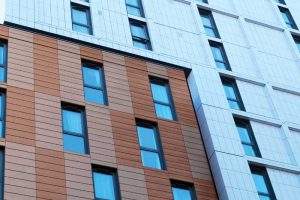 [2]
[2]Material makeup
As manufacturers of WPCs move closer to zero waste, they have incrementally increased the amount of recycled material in their products. WPC is made almost entirely from recycled wood and recycled plastic—some are made with upwards of 94 percent pre- and post-consumer recycled material—which prevents materials from being sent to waste streams and landfills, while preserving valuable natural resources. This makes WPC much more sustainable than many other building envelope materials.
Wood flour is recycled from sawdust, planer shavings, or other scrap material from window trim, door frames, lumber, or cabinet pieces that would otherwise be discarded. Through its recycling efforts, a leading manufacturer of composite decking and cladding products prevents more than one million trees from being cut down every year. This is equivalent to about 15,000 football fields of healthy forests preserved annually.3 In addition, its manufacturing process of WPCs does not involve the use of rainforest species, thereby safeguarding threatened trees and curbing deforestation. While any wood species can be incorporated into WPCs, the most common are maple, pine, and oak.
The plastic in composite cladding is derived from milk jugs, shampoo bottles, grocery bags, laundry detergent containers, and other recycled packaging material. The average American family uses approximately 1,500 plastic bags each year, with each bag being used for an average of just 12 minutes.4 If not recycled, these plastic bags likely end up in landfills or the ocean, where they could remain for up to 1,000 years.5 That said, it is this same resistance to decomposing that helps composite cladding last such a long time. As many as 2,000 plastic bags can be used in the manufacturing of a single WPC board, which means one manufacturer can recycle an average of 45 million kg (100 million lb) of plastic each year. That is the weight of approximately 227 Boeing 747s.6
Manufacturing process
Working toward zero waste, WPC producers have, for some time now, been increasing efficiencies in the manufacturing process. These improvements are yet another reason why WPC is highly sustainable.
Composite cladding manufacturers with dedicated recycling facilities can recycle both post-consumer and post-industrial polyethylene (PE)—the most common form of plastic waste. And thanks to automated material shredding and sorting, it is becoming faster and less expensive for manufacturers to incorporate recycled materials into building products.
 [3]
[3]Since it is important these plastics are not entering the waste stream, some manufacturers ensure 100 percent of the material is reclaimed in the manufacturing process. When the PE arrives at a recycling facility, for example, it undergoes a battery of tests—including thermal, moisture, and infrared analysis—to confirm the molecular structure of the polymers and to provide insight into the history of the sample. Inspectors examine the individual physical properties of the samples, check for possible degradation, and determine whether any contaminants are present. If the samples meet strict quality requirements, they are staged in a warehouse for further inspection. If the samples fail, they are sent to alternate recycling operations with less stringent requirements.
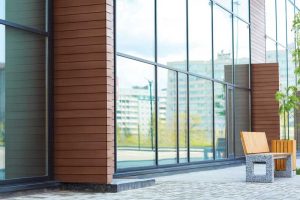 [4]
[4]While manufacturing composite cladding requires a constant source of water, some manufacturers use a closed-loop system to maintain sustainability. A closed-loop system uses a reservoir to store and recycle the same water every day, preventing billions of gallons of water—enough to fill 5,300 Olympic-size swimming pools—from ending up in the waste stream.3
Performance/lifecycle
Doubling the life of a building essentially halves the environmental impacts of its construction, which is why the durability of a material, along with its performance, are crucial when considering its sustainability.
WPCs combine the best qualities of recycled wood—such as strength and low cost—with the long-lasting resilience of recycled plastic, which is less prone to water absorption and insect infestation. Blending these two materials together is the reason why WPCs last so long, and why they are sustainable from start to finish.
Unlike solid wood, the durable composite core of WPC cladding ensures exceptional resistance to rotting, cracking, insects, and decay. A three-sided cap layer protects against fading and staining, which is common with solid wood cladding, and it has a finished surface on both the top and bottom to further prevent water absorption.
Composite cladding also never needs sanding, staining, painting, or sealing. There are environmental dangers associated with volatile organic compounds (VOCs) released from stain and paint. VOCs are the leading cause of ground-level air pollution and indoor air pollution, which can adversely impact the health of building occupants.7 When solid wood is stained or painted to maintain its durability, it will then need to be refinished with more stain or paint every couple of years, which creates a continual cycle of chemical emissions. The chemicals used in treated wood are generally not good for humans either. Since composite cladding is highly durable and never needs to be stained or painted, it is free of these toxic chemicals and preservatives.
Further, when the WPC is finished being used as cladding, the material can be recycled into something new. Wood treated with chemicals, on the other hand, cannot be burned or recycled when its use as cladding is complete.
Performance of composite cladding
Compared with other building envelope materials, WPC stands apart as the most sustainable option—both in terms of durability and material makeup.
Wood Cladding
Appearance
Wood siding—including shiplap, tongue and groove, and board and batten—is prone to fading, chipping, and staining. It can also develop mold and mildew stains.
Installation
Wood siding requires multiple trades (carpenters, painters, and so on) to install and finish. The siding will need to be refinished (and sometimes repaired) every few years—which is a time-consuming process entailing scraping, sanding, pressure-washing, and re-staining or re-painting.
Durability
Wood splits, splinters, and is particularly affected by freeze/thaw cycles. Water absorption is dependent on the quality and age of the finish. If the siding is not maintained, the durability will be compromised.
Recycled content
Wood cladding contains no recycled content if purchased new. Some wood cladding is made from endangered hardwood species, which results in negative environmental repercussions.
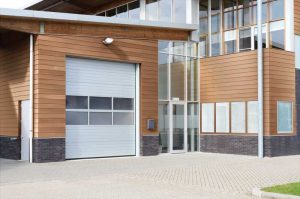 [5]
[5]Engineered cladding products
Appearance
While engineered cladding products, such as fiber cement, may be embossed with a woodgrain pattern, they must be painted, which means there will be no multi-chromatic streaking that gives composite cladding the authentic and natural appearance of wood. Engineered cladding products are also prone to fading and cracking.
Installation
Since engineered cladding releases silica when cut, the Occupational Safety and Health Administration (OSHA) requires exposure controls and protective equipment for all installers. A specialized blade is also needed to reduce silica dust. The material can break under its own weight, so it requires careful handling to avoid product loss. Installation can vary based on climate and wind requirements, which makes scheduling more difficult.
Durability
Engineered cladding products tend to be brittle and can fracture if nailed close to the edge. The finish and face can spall (flake or break off) in cold environments. Like wood, the amount of water that engineered cladding absorbs depends on the quality and age of the finish, so it must be effectively maintained to prevent deterioration. Engineered cladding is highly susceptible to impact damage and freeze/thaw cycles.
Recycled content
Engineered cladding contains no recycled content.
Stucco
Appearance
Unlike plank cladding, stucco has a very limited range of appearances, and there are limited trim options that work well with the material. Stucco is resistant to rot, mold, fire, and insects. Moreover, it is often used in drier climates since it is prone to moisture-related issues.
Installation
Stucco is very labor-intensive to install, requiring a two- to three-step application plus painting (dash coat, scratch coat, brown coat, and finish coat) by a concrete contractor. Since it is made of cement sand and water, stucco is heavy. All layers of stucco must be uniform to perform well. Additionally, stucco requires two layers of building paper or wrap plus lath reinforcing. Improper installation can result in extensive interior wall and structural damage.
Durability
Stucco is prone to cracking due to its brittle nature, particularly if the foundation of the building settles. Stucco is also porous and will absorb water more readily than other materials, which can cause it to develop dark spots or grow mold. The material is sometimes affected by freeze/thaw cycles.
Recycled content
Stucco typically does not contain recycled content, although some may use post-consumer recycled sand aggregate from crushed, screened waste concrete.
Brick and stone masonry
Appearance
Both brick and stone have a classic look often seen on more traditional homes. These materials have a wide range of aesthetics beyond typical red brick and field stone. Brick is available in different colors and course patterns, and can be painted, while stone can be laid in a variety of patterns. Manufactured brick and stone veneers offer another option.
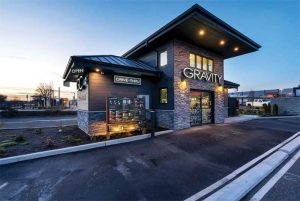 [6]
[6]Installation
Brick and stone installations are quite labor-intensive since the products are heavy. Exterior brick and stone require a wider foundation wall to support their own weight and accommodate the code-required 25-mm (1-in.) air space. They also require steel support lintels over windows, doors, and gable-ends, as well as brick ties, through-wall flashings, and weep holes for water drainage.
Durability
Brick is a highly durable product, but it absorbs water and can spall when exposed to excess moisture. Depending on the brick’s water absorption rate and saturated coefficient, it can be affected by freeze/thaw cycles. Brick is also subject to efflorescence, or crystalline deposits of water-soluble salt on the brick’s surface.
Recycled content
Some bricks may contain pre-consumer recycled materials, such as overburden from mining, washings from aggregate processing, grog, sawdust, and metallic oxides. This pre-consumer recycled content is typically low, around 15 percent.
Composite cladding
Appearance
Composite cladding has an authentic wood grain and color variation that gives it an appearance similar to solid wood—but without the fading, cracking, and decay that is typical of wood cladding.
Installation
Installation is safer and easier than most other cladding options. Composite cladding is available in longer board lengths than wood or fiber cement, which reduces splices and labor. Since the boards are pre-finished, there are no extra finishing steps or excessive ongoing maintenance required, which further reduces labor time and expense. Unlike fiber cement, no potentially harmful substances are released during cutting.
Durability
Composite cladding will not crack, splinter, peel, rot, decay, or suffer insect infestation, like wood. Composite cladding may absorb a negligible amount of water, but is not affected by freeze/thaw cycles.
Recycled content
Composite cladding is made almost entirely of recycled content. It is manufactured without toxic chemicals and with zero wastewater. In addition, it can be recycled at the end of its life, unlike wood treated with chemicals, which cannot be burned or recycled at the end of its life.
Design benefits of composite cladding
Beyond its sustainability and performance attributes, composite cladding allows designers to provide the warm look of wood with a more durable material, while also staying on-trend with a mixture of exterior materials. While monolithic expanses of synthetic stucco (exterior insulation finishing systems [EIFS]), brick, wood, or fiber cement were once the norm, today’s buildings typically feature a combination of materials. Organic looking products with warm wood tones are now placed alongside poured-in-place concrete and glass or EIFS and stone. This is seen everywhere from single-family residences to commercial buildings, as it is a fast, simple solution for creating a great aesthetic virtually indistinguishable from newer buildings and adds an element of warmth.
WPCs can be used for many different components in the built environment, including decking, soffits, screen facades, rainscreen cladding, and even trim elements when cut to size. WPCs can also be manufactured in many different shapes, colors, and textures. Lengths and colors can be mixed and matched to create a unique, custom look, and boards can be installed vertically, horizontally, or diagonally. With these design options, architects can achieve a variety of styles, from subtle and rustic to bold and modern.
 [7]
[7]Inspired by nature
The embossing of WPCs has advanced to the point where the material is virtually indistinguishable from solid wood. Further, color options are abundant, not constrained by the regional availability of a particular wood species. Rich color palettes and varied grain patterns are available in a range of browns and grays. Classic browns range from rich mid-tones to the deepest brown, with these colors adding depth and drama. The darker choices are especially well-suited to Craftsman-style or Mediterranean homes. Reddish browns are timeless and classic, yet still unique. These colors bring to mind cinnamon, rosewood, and western red cedar. Reddish tones provide warmth, energy, and a pop in the landscape. Blonde oak tones are trending in the industry and offer a subtle sandy hue for those drawn to the natural, Scandinavian-inspired look. Grays have undercurrents of blue or sandy beige, evoking thoughts of rocky shorelines and weathered wood. Gray cladding is the perfect choice for coastal homes, but can add quiet sophistication to urban spaces as well.
When it comes to performance, ease of maintenance, and design capabilities, composite cladding outperforms many alternative cladding materials. It is highly durable and sustainable, and thanks to its nature-inspired embossing, composite cladding emulates natural wood better than alternative materials.
WPCs may well be the building material of the future, offering the ideal balance between sustainability and remarkable performance capabilities. After all, if something is worth building, it is worth protecting.
Notes
1 See the definition of zero waste: https://zwia.org/zero-waste-definition[8].
2 Refer to the document by G. Unruh, D. Kiron, N. Kruschwitz, M. Reeves, H. Rubel, and A.M. zum Felde, “Investing For a Sustainable Future,” MIT Sloan Management Review.
3 For more information, visit https://balance.fiberondecking.com[9].
4 Also see National Geographic 2018: Fast facts about plastic pollution, www.nationalgeographic.com/science/article/plastics-facts-infographics-ocean-pollution[10].
5 See “Degradation Rates of Plastics in the Environment,” by ACS Publications 2020, pages 3,495, 3,499–3,500, and 3503: https://pubs.acs.org/doi/10.1021/acssuschemeng.9b06635[11].
6 Refer to the United States Environmental Protection Agency (EPA) 2022, Technical overview of volatile organic compounds, at www.epa.gov/indoor-air-quality-iaq/technical-overview-volatile-organic-compounds[12].
7 See “Fiberon Wildwood Composite Cladding,” pages 26–27, at fiberon.widen.net/s/npdt7xjgf6/lit_clad_brochure_wildwood-composite-cladding[13].
- [Image]: https://www.constructionspecifier.com/wp-content/uploads/2024/03/BST_Clad_WLD_Eden_Wenge_001.jpg
- [Image]: https://www.constructionspecifier.com/wp-content/uploads/2024/03/Fig1_CladdingOptions.jpg
- [Image]: https://www.constructionspecifier.com/wp-content/uploads/2024/03/Fig2_CladdingOptions.jpg
- [Image]: https://www.constructionspecifier.com/wp-content/uploads/2024/03/Fig3_CladdingOptions.jpg
- [Image]: https://www.constructionspecifier.com/wp-content/uploads/2024/03/Fig4_CladdingOptions.jpg
- [Image]: https://www.constructionspecifier.com/wp-content/uploads/2024/03/Fig5_CladdingOptions.jpg
- [Image]: https://www.constructionspecifier.com/wp-content/uploads/2024/03/BST_Clad_WLD_Eden_Tupelo_004.jpg
- https://zwia.org/zero-waste-definition: https://zwia.org/zero-waste-definition/
- https://balance.fiberondecking.com: https://balance.fiberondecking.com
- www.nationalgeographic.com/science/article/plastics-facts-infographics-ocean-pollution: https://www.nationalgeographic.com/science/article/plastics-facts-infographics-ocean-pollution
- https://pubs.acs.org/doi/10.1021/acssuschemeng.9b06635: https://pubs.acs.org/doi/10.1021/acssuschemeng.9b06635
- www.epa.gov/indoor-air-quality-iaq/technical-overview-volatile-organic-compounds: https://www.epa.gov/indoor-air-quality-iaq/technical-overview-volatile-organic-compounds
- fiberon.widen.net/s/npdt7xjgf6/lit_clad_brochure_wildwood-composite-cladding: https://fiberon.widen.net/s/npdt7xjgf6/lit_clad_brochure_wildwood-composite-cladding
Source URL: https://www.constructionspecifier.com/towards-a-zero-waste-future-sustainability-and-design-benefits-of-composite-cladding/
 Author
Author